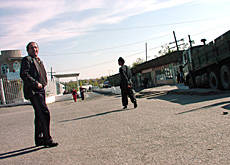A valley divided

The Fergana Valley – about half the size of Switzerland and split by the borders of three republics - is a fragile melting-pot in the heart of Central Asia.
The potential for conflict is ever present among the eight million inhabitants who belong to dozens of ethnic and religious groups.
Our first glimpse of the place is from the Kamchik Pass. Rather than a valley, the Fergana looks like an immense plain. Mainly Uzbek territory, it is surrounded by Kyrgyzstan and Tajikistan.
The Fergana is enclosed by two mountain ranges, the Tian Shan and the Alai, which are just visible on the horizon, in the far distance.
This is one of the most densely populated areas in Central Asia. Though ethnically very diverse, the people were moulded together (and to some extent still are) by centuries of co-existence.
Then, with the collapse of the former Soviet Union, the valley was artificially divided up among Uzbekistan, Kyrgyzstan and Tajikistan.
Led by three paternalistic strongmen eager to exercise their newfound sovereignty, the three states soon introduced divisive policies, especially here, in this agricultural region (mainly cotton and wheat are grown), where the boundaries were still a matter of dispute.
Bordering on absurdity
Fergana’s frontiers zigzag across highways, railway lines and through villages.
On deserted roads travellers come across customs posts manned by young guards, busy monitoring the movements of the few farmers who pass their way.
There are also several enclaves, such as Sokh, a sliver of Uzbek land surrounded by Kyrgyz territory and inhabited by Tajiks.
There are villages where the population once lived together as a single community and which now are literally cut in half – a school on one side of the border, a market on the other.
Water: a disputed resource
Water – an increasingly rare resource – is the cause of many cross-border conflicts.
During the Soviet era, water allocation was managed at the regional level. Now, each state puts its own interests first.
For instance, most of the Valley’s dams, which are largely in Kyrgyzstan, are filled during the summer to produce electricity in winter.
But since this is done during the hottest part of the year, the regions downstream are left dry and parched, in particular the Uzbek part of the Fergana Valley, which is totally dependent for its water supply on neighbouring Kyrgyzstan.
Unemployment and fundamentalism
The new frontiers generate tensions, bureaucracy and inefficiencies. They are still not understood by the local communities, joined together by years of life in common and mixed marriages.
The local economy, too, is in difficulty. Unemployment is very high among young people, perhaps even as high as 70 or 80 per cent.
And it may well be for this reason that there is a problem of Islamic fundamentalism. Pressure on the borders of Uzbekistan by fundamentalist groups has led to a number of clashes.
Mines have been laid in many areas, and efforts to suppress the dissident groups continue. Ironically, the vast majority of the local people are themselves Muslims.
Outbreaks of violence
Given the circumstances, fresh outbreaks of violence are always possible. In 1990, there were riots in Osh between Uzbeks and Kyrgyzstanis over alleged injustices in the allocation of land, resulting in over 300 deaths.
In 1999, Islamic Uzbek militiamen in revolt against their government kidnapped a number of Japanese nationals.
The episode ended with the Uzbek army bombing the rebels’ camps in Kyrgyzstan, the freeing of the hostages and renewed friction between the two countries.
Most experts fear outbreaks of violence in the region.
In the 1990s, riots erupted in Osh between Uzbeks and Kyrgyz over alleged injustices in the allocation of land. More than 300 were killed.
In 1999, Islamic Uzbek militiamen kidnapped a number of Japanese nationals.
They were ultimately released, but only after the Uzbek army bombed rebel camps in Kyrgyzstan, fuelling fresh tensions between the two countries.
“Too many players”
Acutely aware of the delicate situation, many countries – including Switzerland – have become engaged in development projects, party to prevent future flare-ups.
There has been a plethora of schemes to promote dialogue, conflict resolution and rational water management.
Although well intentioned, some experts warn these measures could be having an adverse effect.
“There are now too many players active in the region,” said a resident expert.
“And with too much money washing around, there is a danger of stifling people’s creativity so that they fail to work out practical solutions for themselves.”
swissinfo, Marzio Pescia and Jean-Didier Revoin in Fergana
The Fergana Valley marks a crossroads between Uzbekistan, Kyrgyzstan and Tajikistan.
Its high population density, large number of ethnic groups, limited resources and widespread unemployment make it an area of conflict.
Stalin is partly to blame: to divide-and-rule the population he drew complicated borders between the three republics of the Fergana Valley.
Many international aid donors have become involved in the region, including the Swiss, whose main concern is to encourage cross-frontier dialogue and promote rational management of natural resources.
The Fergana Valley
Area: 22,000 square km;
Population: approx. 8 million;
One of the most densely populated parts of Central Asia;
A mainly agricultural region (cotton and wheat).

In compliance with the JTI standards
More: SWI swissinfo.ch certified by the Journalism Trust Initiative










You can find an overview of ongoing debates with our journalists here . Please join us!
If you want to start a conversation about a topic raised in this article or want to report factual errors, email us at english@swissinfo.ch.